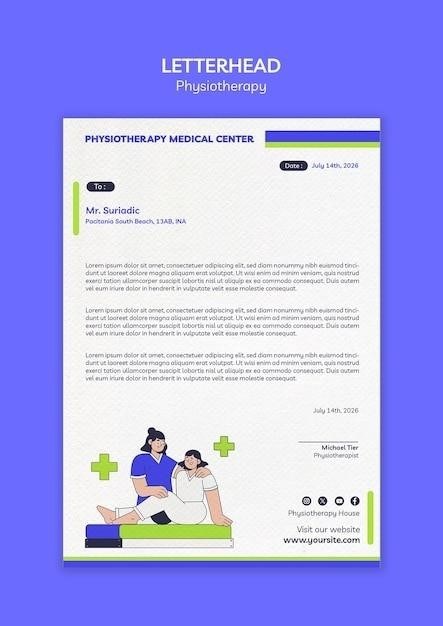This document provides a detailed rehabilitation protocol for adductor strains, a common injury among athletes․ The protocol is designed to guide individuals through a progressive series of exercises and activities, ultimately leading to a safe return to sport․ The program incorporates various phases, including rest and ice, range of motion, strengthening, proprioception, and functional exercises․ This comprehensive approach aims to optimize healing and minimize the risk of re-injury․
Introduction
Adductor strains are a common injury among athletes, particularly those involved in sports requiring rapid changes in direction, kicking, and twisting motions․ These injuries can range in severity, from mild muscle fiber tears to complete ruptures․ This rehabilitation protocol provides a comprehensive guide for individuals recovering from adductor strains, offering a structured approach to facilitate optimal healing and minimize the risk of re-injury․ This protocol outlines a progressive series of exercises and activities, with each phase building upon the previous one, ultimately enabling a safe and successful return to sport․
Understanding Adductor Strains
Adductor strains involve damage to the muscles that run along the inner thigh, responsible for bringing the legs together․ These muscles are crucial for various athletic movements, including kicking, pivoting, and side-stepping․ Adductor strains can occur due to sudden forceful contractions, overstretching, or repetitive stress․ The severity of the injury can vary, ranging from mild muscle fiber tears to complete ruptures․ A proper understanding of adductor strains is essential for developing an effective rehabilitation plan, ensuring optimal healing and a safe return to activity․
Causes of Adductor Strains
Adductor strains are often caused by a combination of factors, including⁚
- Overuse⁚ Repetitive movements, particularly in sports that involve kicking, pivoting, or rapid changes in direction, can lead to muscle fatigue and increased susceptibility to injury․
- Muscle Imbalances⁚ Weak adductor muscles or imbalances between adductors and opposing muscle groups can increase the strain on the adductors, making them more prone to injury․
- Inadequate Warm-Up⁚ Failure to adequately warm up before engaging in physical activity can leave the muscles unprepared for the demands of exercise, increasing the risk of strain․
- Poor Technique⁚ Incorrect form during exercise or sports activities can place excessive stress on the adductor muscles, making them more vulnerable to injury․
- Sudden Forceful Contractions⁚ Sudden, forceful movements, such as those involved in kicking or pivoting, can cause muscle strains if the adductors are not properly prepared․
Symptoms of Adductor Strains
Adductor strains can manifest with a range of symptoms, depending on the severity of the injury․ Common signs include⁚
- Pain⁚ A sharp, sudden pain in the groin area, often felt during or immediately after activity․ The pain may also be gradual and worsen over time․
- Tenderness⁚ A painful feeling to the touch in the affected area․
- Swelling⁚ Inflammation and swelling around the injured muscle․
- Bruising⁚ Discoloration of the skin in the affected area, often appearing a few days after the injury․
- Difficulty Moving⁚ Limited range of motion in the hip joint due to pain․
- Muscle Weakness⁚ A feeling of weakness or difficulty using the affected muscles․
- Muscle Spasm⁚ Involuntary muscle contractions that can contribute to pain and discomfort․
Diagnosis of Adductor Strains
A thorough evaluation is crucial for diagnosing an adductor strain and determining the appropriate treatment plan․ Here’s what a healthcare professional may do⁚
- Physical Examination⁚ The doctor will examine the injured area, assess your range of motion, and test your muscle strength․ They may also ask about the mechanism of injury and your symptoms․
- Imaging Tests⁚ To confirm the diagnosis and assess the severity of the injury, imaging tests such as an ultrasound or magnetic resonance imaging (MRI) may be ordered․ These tests can visualize the affected muscles and tendons, revealing any tears or other damage․
- Ruling Out Other Conditions⁚ The doctor may need to rule out other conditions that can cause similar symptoms, such as a hip flexor strain, a sports hernia, or a nerve injury․
Adductor Strain Rehab Protocol
The rehabilitation protocol for an adductor strain typically involves a structured, progressive approach, aiming to restore muscle function and allow a safe return to activity․ The program is divided into five phases, each building upon the previous one⁚
- Phase 1⁚ Rest and Ice⁚ This initial phase focuses on reducing inflammation and pain․ It involves resting the injured area and applying ice for 15-20 minutes at a time, several times a day․
- Phase 2⁚ Range of Motion and Light Stretching⁚ Once the initial inflammation subsides, gentle range of motion exercises and light stretching are introduced to regain flexibility and reduce stiffness․
- Phase 3⁚ Strengthening Exercises⁚ As healing progresses, strengthening exercises are incorporated to rebuild muscle strength and endurance․ These exercises may involve using resistance bands, weights, or bodyweight exercises․
- Phase 4⁚ Proprioception and Functional Exercises⁚ This phase focuses on improving balance, coordination, and stability․ Exercises may include single-leg squats, hopping, and agility drills․
- Phase 5⁚ Return to Sport⁚ The final phase gradually introduces the athlete back to their sport, starting with low-intensity activities and gradually progressing to higher intensity levels․
Phase 1⁚ Rest and Ice
The initial phase of an adductor strain rehabilitation protocol focuses on minimizing inflammation and pain, which are crucial for promoting healing․ This phase emphasizes rest and ice application․ Resting the injured area means avoiding activities that aggravate the pain․ Applying ice to the affected muscle can help reduce swelling and inflammation․ Ice should be applied for 15-20 minutes at a time, several times a day․ It is important to wrap the ice in a towel to prevent direct contact with the skin, as this can cause frostbite․ The RICE (rest, ice, compression, and elevation) principle is often recommended during this phase to further reduce inflammation․ Compression with a bandage can help reduce swelling, and elevating the injured leg above the heart can also help with drainage․
Phase 2⁚ Range of Motion and Light Stretching
Once the initial inflammation has subsided, the focus shifts to restoring range of motion and flexibility in the injured area․ This phase typically begins a few days after the injury․ Gentle range-of-motion exercises are introduced to gradually increase the movement of the hip and groin․ These exercises might include slow and controlled hip flexions, extensions, and rotations․ Light stretching can also be incorporated, focusing on the adductor muscles, hamstrings, and hip flexors․ The goal is to improve flexibility and reduce muscle tightness without causing further pain or discomfort․ Stretching should be performed slowly and gently, holding each stretch for 15-30 seconds․ If any pain is felt, the stretch should be stopped immediately․ As the pain and discomfort reduce, the range of motion and intensity of stretching can be gradually increased․
Phase 3⁚ Strengthening Exercises
Once adequate range of motion is achieved, the focus shifts to strengthening the adductor muscles․ This phase typically begins a couple of weeks after the injury and involves progressively increasing the intensity and resistance of exercises․ Start with light resistance exercises, such as isometric holds or using resistance bands, targeting the adductor muscles․ As the muscles become stronger, progress to more challenging exercises, such as hip adduction with weights or resistance bands․ Exercises should be performed slowly and controlled, focusing on proper form and technique․ It is important to avoid any movements that cause pain․ The number of repetitions and sets can be gradually increased as the muscles gain strength․ Examples of exercises include hip adductor machine, side-lying hip adduction with a resistance band, and standing hip adduction with a resistance band․ Consistency is key in this phase; aim to perform these exercises 2-3 times per week․
Phase 4⁚ Proprioception and Functional Exercises
This phase focuses on improving proprioception, which is the body’s awareness of its position and movement in space․ It also introduces functional exercises that mimic the movements required for the athlete’s specific sport; Proprioceptive exercises often involve balance and coordination activities, such as standing on one leg, performing single-leg squats, or walking on uneven surfaces․ These exercises help to retrain the muscles and joints to respond appropriately to different demands and reduce the risk of re-injury․ Functional exercises mimic the movements required in the athlete’s sport, such as running, jumping, pivoting, and kicking․ These exercises should be gradually progressed in intensity and complexity as the athlete gains strength and coordination․ It is essential to listen to your body and avoid any movements that cause pain․ The goal is to prepare the body for the demands of sport while minimizing the risk of re-injury․
Phase 5⁚ Return to Sport
The final phase of rehabilitation focuses on a gradual and safe return to the athlete’s sport․ This phase involves a progressive increase in the intensity and duration of training, with a focus on simulating the specific demands of the athlete’s sport․ The athlete may start with light drills and gradually progress to more demanding activities․ It is essential to monitor the athlete’s progress closely and adjust the training load accordingly․ The athlete should be able to perform all the required movements without pain or discomfort․ The goal is to ensure that the athlete is fully recovered and ready to participate in their sport at the highest level․ The return to sport should be a gradual process, with a focus on minimizing the risk of re-injury․ It is important to listen to the athlete’s body and allow for rest and recovery as needed․ The athlete may also benefit from working with a sports medicine professional to ensure a safe and effective return to sport․
Prevention of Adductor Strains
Preventing adductor strains requires a multifaceted approach that addresses the underlying factors contributing to these injuries․ A well-structured warm-up routine that includes dynamic stretching and targeted exercises for the adductor muscles can help prepare the body for activity․ Prioritizing proper technique during activities involving twisting, turning, and kicking can minimize strain on the adductor muscles․ Furthermore, maintaining a balanced strength program that targets not only the adductor muscles but also the surrounding hip flexors, abductors, and core muscles is crucial․ Adequate rest and recovery are essential to prevent muscle fatigue and overuse, which can increase susceptibility to injury․ Finally, addressing any underlying imbalances or weaknesses in the hip and lower body can help reduce the risk of developing adductor strains․ By implementing these preventive measures, athletes can significantly reduce their risk of experiencing adductor strain․

Adductor strain rehabilitation is a crucial process for athletes seeking to return to their sport after an injury․ This protocol provides a comprehensive and evidence-based approach that emphasizes progressive exercise and activity modification․ By adhering to the outlined phases, individuals can effectively address the injury, promote tissue healing, and regain functional strength and stability․ Remember, consistent adherence to the program and close collaboration with a qualified healthcare professional are essential for optimal outcomes․ With proper guidance and dedication, athletes can successfully overcome adductor strains and return to their desired level of activity․









